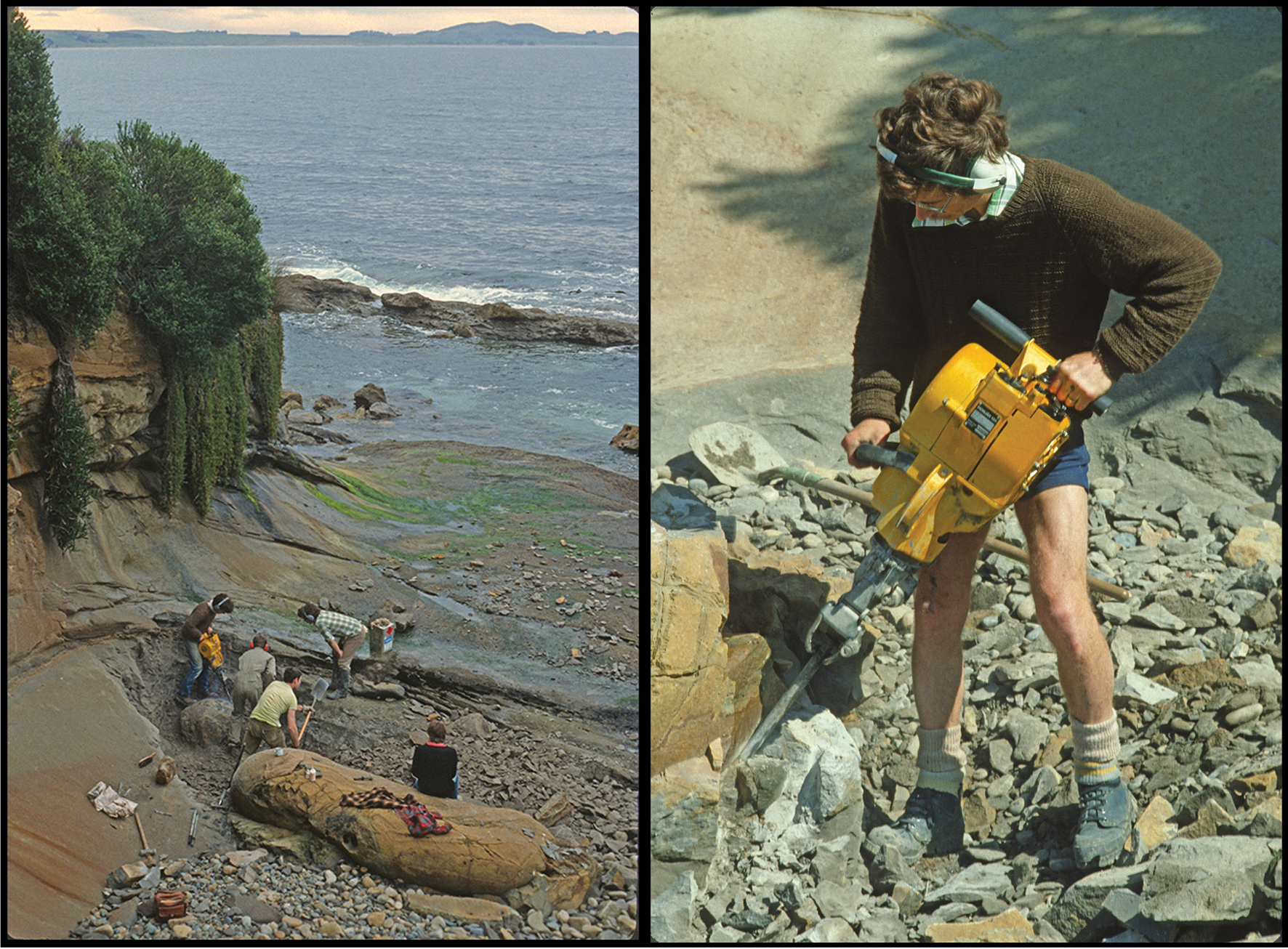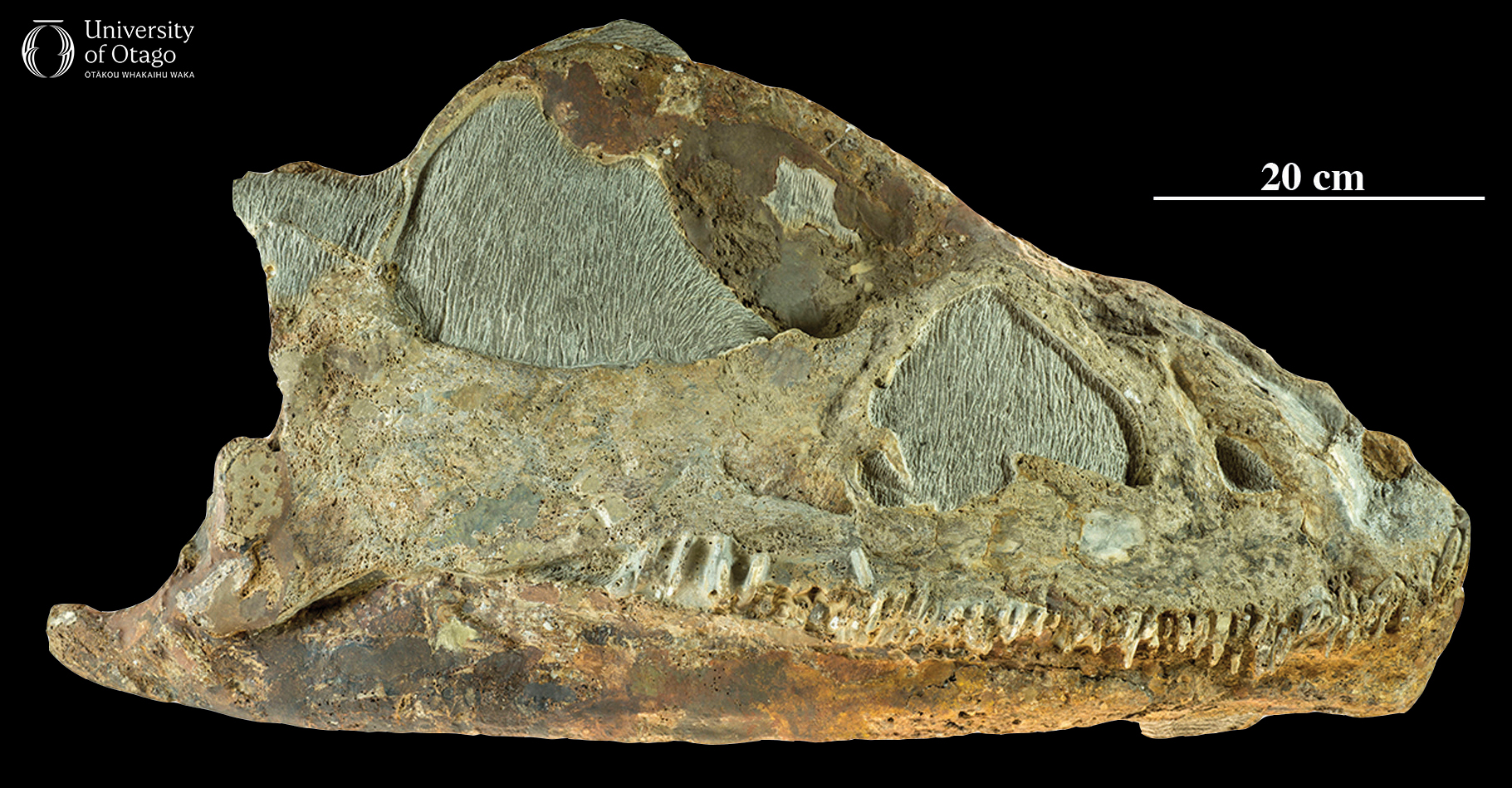14 Most complete dinosaur-aged reptile from Aotearoa
Sauropsida, Plesiosauria: Kaiwhekea katiki
The plesiosaur Kaiwhekea katiki, named by Arthur Cruickshank and Ewan Fordyce in 2002, is one of the most complete fossil reptiles described from New Zealand. The seven metre long fossil includes the skull, jaws, vertebrae and ribs articulated almost in life position.

Staff from the Department of Geology and other volunteers extracting the plesiosaur fossil from the discovery location near Matakaea (Shag Point). Image credit: Unknown. |
Plesiosaurs and other marine reptiles, such as mosasaurs, have been known from New Zealand since the 1860s when British anatomist and paleontologist Richard Owen identified the first specimens. Much field work was carried out in the late 1800s, leading to recognition of many new species. However, all of the named specimens are fragmentary, without clearly associated skull and skeleton. Kaiwhekea is the first plesiosaur described from New Zealand to have skull, limbs and other elements clearly associated.
 |
Did you know there is a 3D printable model of this fossil for you to view online and download? Follow this link to learn more: 3D model—Most complete dinosaur-aged reptile from Aotearoa. |
Kaiwhekea was recovered from the Katiki Formation near Matakaea (Shag Point), Otago where some blocks with vertebrae showing on the surface were discovered by amateur fossil collectors Gary Raper and his son in early 1983. The plesiosaur was preserved inside a large concretion which was riddled with cracks, allowing it to be broken apart into manageable blocks. Over about 30 days of field work, the numbered blocks were hauled up the steep cliff behind the beach and taken to the Department of Geology for preparation. As excavation proceeded, it was discovered that percolating water had decayed much of the bone leaving natural moulds in the rock. Most of the bones, however, are articulated and were barely disturbed from life position when the animal’s carcase fell onto the muddy sea floor in a sheltered embayment where it was preserved from would-be predators and scavengers in a soft, oxygen-poor sediment. Belemnite fossils and fragmentary mosasaurs from nearby indicate an age of Haumurian Stage, or Late Cretaceous – around 70 million years old.

Researcher studying Kaiwhekea katiki (specimen OU 12649) in the Southern Land, Southern People gallery at Tūhura Otago Museum in Ōtepoti, Dunedin. Image credit: RE Fordyce. |
The particular combination of skull features is unlike any previously-described plesiosaur, which is why a new generic name Kaiwhekea was proposed. On the skull of Kaiwhekea, the large forward-looking orbit hints at binocular vision. A large temporal fenestra indicates large fast-acting and/or powerful jaw muscles. Teeth are slim, small and roughly uniform in shape and size, consistent with a diet of medium-sized soft-bodied prey such as fish. The neck is long, but in life was probably not particularly flexible. Proportions of the hind-flipper are consistent with fast swimming capabilities. Perhaps the plesiosaur fed at depth, where the large eyes might have been an advantage.
Reconstructions of the ancient geography of Zealandia suggest that, when Kaiwhekea lived, the Otago region was much closer to the polar circle. This region of ancient Zealandia probably had quite a seasonal climate, with long summer days and long winter nights. At the time, New Zealand was already isolated from Gondwana, but Australia, Antarctica and South America were still connected.

The skull of Kaiwhekea katiki (specimen OU 12649). Image credit: RE Fordyce. |
This is the only known specimen of Kaiwhekea, so little can be said about the time range for the species. As for elsewhere in the world, no plesiosaur remains younger than Cretaceous have been found in New Zealand. It is widely thought that plesiosaurs went extinct during the same event at the end of the Cretaceous that accounted for the demise of non-avian dinosaurs. The unique specimen of Kaiwhekea katiki is on loan to Tūhura Otago Museum in Ōtepoti Dunedin in the Southern Land, Southern People gallery.
—Written by R. Ewan Fordyce, with additional contributions by Daniel B Thomas
| Specimen number: OU 12649 | Age: Approximately 70 million years old (late Cretaceous, upper Haumurian stage) |
| Locality: Matakaea (Shag Point), Otago | Rock Formation: Katiki Formation |
| Collected by: RE Fordyce, J Williams, and team | |
| Citation: Cruickshank AR, Fordyce RE. 2002. A new marine reptile (Sauropterygia) from New Zealand: further evidence for a Late Cretaceous austral radiation of cryptoclidid plesiosaurs. Palaeontology 45:557–575. doi.org/10.1111/1475-4983.00249 | |
Massive, indurated, dark grey sandy siltstone.
The series of bones forming the flexible 'backbone' structure of the animals named for possessing these bones, the vertebrates.
Sedimentary rock cemented into a solid structure through the gradual precipitation of minerals into the pore spaces between sedimentary grains.
An impression of part of an organism preserved in sediment.
Body structures like bones or shells are positioned as they would have been in life.
An environment that lacks oxygen.
83.6 to 66.0 million years ago.
100.5 to 66 million years ago. The final epoch of the Cretaceous Period.
Openings in the skull for the eyes.
Vision using two eyes with overlapping fields of view, allowing good perception of depth.
Opening in the skull behind the orbit. A site of muscle attachment.
An ancient landmass that existed from the late Precambrian to the Jurassic, which upon fragmenting gave rise to Africa, Antarctica, Australia, India, Madagascar, South America, and Zealandia.
A mass extinction event that occurred around 66 million years ago. An asteroid impact is generally considered to have been the cause.
All dinosaurs except birds. Examples include Deinonychus antirrhopus and Tyrannosaurus rex.
See: Tūhura Otago Museum, Southern Land, Southern People.

